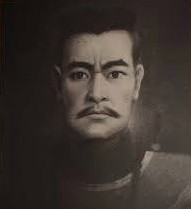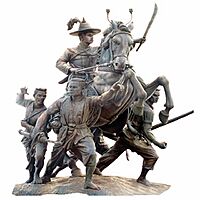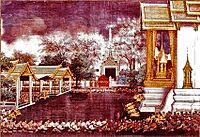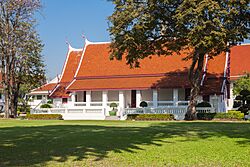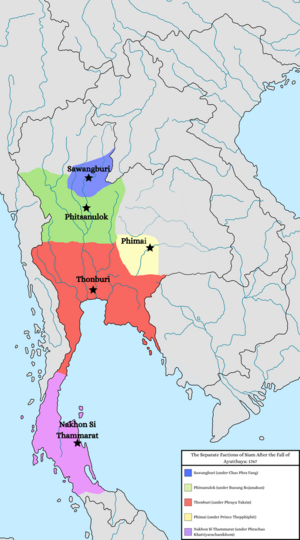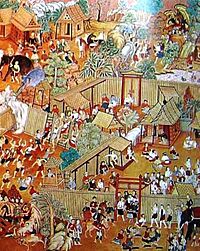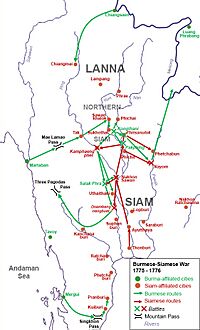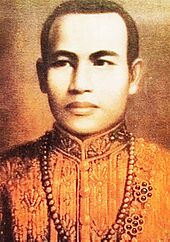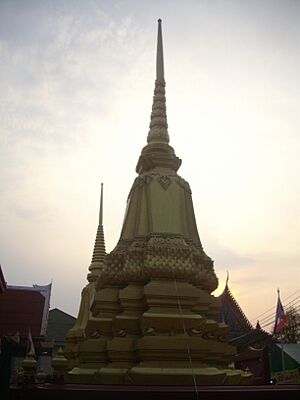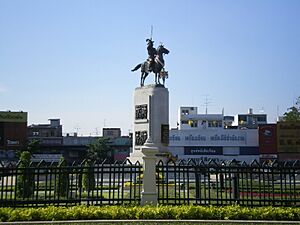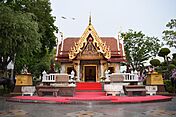Taksin facts for kids
Quick facts for kids
|
|
|---|---|
| King of Thonburi | |

Statue of Taksin the Great at Hat-Sung Palace (Wat Khung Taphao), Uttaradit Province, Thailand)
|
|
| King of Siam | |
| Reign | 28 December 1767 – 1 April 1782 |
| Coronation | 28 December 1767 |
| Predecessor | Ekkathat (as King of Ayutthaya) |
| Successor | Phutthayotfa Chulalok (Rama I) (as King of Rattanakosin) |
| Viceroy | Inthraphithak |
| Born | 17 April 1734 Ayutthaya, Ayutthaya |
| Died | 7 April 1782 (aged 47) Bangkok, Siam |
| Burial | Wat Intharam, Bangkok |
| Spouse | Batboricha |
| Issue | 21 sons and 9 daughters, including:
|
| House | Thonburi dynasty |
| Father | Yong Saetae (Zheng Yong) |
| Mother | Nok-lang (later Princess Phithak Thephamat) |
| Religion | Theravada Buddhism |
King Taksin the Great was the only king of the Thonburi Kingdom. He ruled Thailand from 1767 to 1782. Before becoming king, he was an important leader in the Ayutthaya Kingdom. He helped free Siam from Burmese rule after the city of Ayutthaya was destroyed in 1767.
After the war, Siam was divided among different warlords. Taksin worked to unite the country again. He made Thonburi the new capital because Ayutthaya was badly damaged. His time as king was full of wars. He fought to stop new Burmese attacks and to control northern Thai kingdoms like Lanna, the Laotian areas, and Cambodia.
Even with all the fighting, Taksin also focused on running the country. He worked on trade, built roads and canals, and improved relations with other countries. He also helped bring back literature and arts like drama and painting. He set up rules for collecting books to help education and religious studies.
King Taksin was later removed from power and died. His friend, Maha Ksatriyaseuk, became the next king. He started the Chakri dynasty, which still rules Thailand today. Because of his great achievements, Taksin was given the title Maharaj, meaning "The Great."
Contents
Early Life of King Taksin
Family Background
Taksin was born on April 17, 1734, in Ayutthaya. He had a mix of Chinese Teochew, Thai, and Mon family roots. His father, Yong Saetae, was a tax collector from China.
His mother, Nokiang, was of Mon-Thai descent. Her family included important Mon nobles.
Growing Up and Education
A powerful official named Mut, who was the Grand Chancellor, was impressed by young Sin. He adopted him and gave him the Thai name Sin, meaning "money" or "treasure." When Sin was seven, he began his education at a Buddhist temple called Kosawat Temple.
Later, he became a royal page. He learned several languages, including Chinese and Vietnamese. During this time, he met his friend Thongduang. A fortune-teller told them both that they would become kings. They didn't believe it then, but Thongduang later became Rama I, Taksin's successor.
Starting His Career
After spending about three years as a Buddhist monk, Sin joined the service of King Ekkathat. He became a deputy governor and then the governor of Tak. This is how he got the name Phraya Tak.
In 1765, when the Burmese attacked Ayutthaya, Phraya Taksin helped defend the capital. He was given the title Phraya Wachiraprakan. However, he didn't get to govern for long because the country was in a very difficult situation. For over a year, Thai and Burmese soldiers fought fiercely during the Siege of Ayutthaya. Phraya Vajiraprakarn began to have doubts about the fight.
Fighting for Freedom
Leaving Ayutthaya and Gathering Forces
On January 3, 1767, three months before Ayutthaya fell, Taksin left the city. He led about 500 followers to Rayong, on the east coast. It's still a bit of a mystery how he and his men got past the Burmese army surrounding the city. He first went to Chonburi and then to Rayong. There, he built a small army, and his supporters started calling him Prince Tak.
He planned to attack and capture Chanthaburi. A famous story says he told his men, "We are going to attack Chanthaburi tonight. Destroy all our food and tools, because we will eat in Chanthaburi tomorrow morning." This showed his strong determination.
Reuniting Siam
On April 7, 1767, Ayutthaya was defeated by the Burmese. After the capital was destroyed and the Thai king died, the country split into six parts. Taksin controlled the east coast. With his friend Thongduang, who was now called Chao Phraya Chakri, Taksin managed to push back the Burmese. He also defeated other Thai leaders and brought the country back together.
Taksin and his soldiers moved to Chanthaburi. When the governor there refused to help, Taksin launched a surprise night attack. He captured the city on June 15, 1767, just two months after Ayutthaya was destroyed. His army grew quickly because people from Chanthaburi and Trat joined him. These areas had not been ruined by the Burmese, making them a good base for Taksin to prepare to free his homeland.
The Burmese had looted Ayutthaya and didn't seem interested in holding the ruined city. They left only a small group of soldiers there. They needed their main army to fight a Chinese invasion in their own country. On November 6, 1767, Taksin had gathered 5,000 soldiers and 100 ships. He sailed up the Chao Phraya River and took Thonburi, which is across from modern-day Bangkok. He executed the Thai governor whom the Burmese had put in charge. Taking Thonburi was easy because the soldiers there were Thai.
He quickly followed this victory by attacking the main Burmese camp of 3,000 men near Ayutthaya. The Burmese were defeated, and Taksin won back Ayutthaya within seven months of its destruction.
Choosing a New Capital
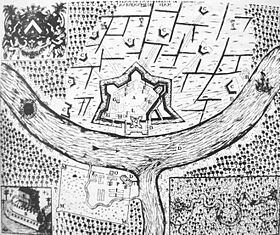
King Taksin took important steps to show he was a worthy king. He treated the remaining members of the old royal family well. He also held a grand ceremony for the former king, Ekkathat. Then, he had to decide where to build the new capital.
Taksin knew that Ayutthaya was too damaged to be easily rebuilt. Also, the Burmese knew Ayutthaya's weak spots. If they attacked again, Taksin's army might not be able to defend it. So, he chose Thonburi as his new capital. Thonburi was closer to the sea, making it harder to invade by land. It also made it difficult for any other ambitious leader to get weapons and supplies further up the Chao Phraya River. Thonburi was a small town, so Taksin's soldiers and sailors could easily defend its walls. If needed, they could also retreat by ship to Chanthaburi.
Taksin's success came from his skills as a warrior and his strong leadership. He often fought at the front, inspiring his men. Two important officials who joined him were Thongduang and Bunma. Thongduang was born in 1737 and later founded the Chakri Dynasty. Bunma, his younger brother, was his deputy.
Thongduang was not in Ayutthaya when it fell. Bunma, however, escaped Ayutthaya and joined Taksin in Chanthaburi. Taksin was so pleased that he promoted Bunma. Later, Taksin also brought Thongduang into his service. Both brothers quickly rose through the ranks. Thongduang became Chao Phraya Chakri, a high-ranking official, and Bunma became Chao Phraya Surasi.
King Taksin's Reign
Becoming King
On December 28, 1767, Taksin was crowned King of Siam at Thonburi Palace. Thonburi became the new capital. He took the official names "Borommoraja IV" and "Phra Sri Samphet X." But he is best known as King Taksin, combining his popular name "Phraya Tak" and his first name "Sin." He was only 34 years old when he became king.
Taksin chose not to return to Ayutthaya. Instead, he made Thonburi his capital because it was closer to the sea, which was better for trade. He spent most of his reign fighting enemies and expanding his kingdom, so he didn't have much time to build Thonburi into a large city.
Uniting the Kingdom
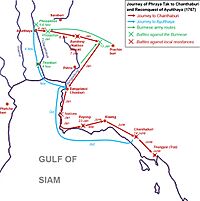
After Ayutthaya was destroyed, the country broke apart. Besides Taksin, several local lords became rulers in different areas like Phimai, Phitsanulok, Fang, and Nakhon Si Thammarat. From 1768 to 1771, Taksin launched military campaigns to defeat these rivals. Thonburi then became the new center of power in Siam.
Battles with Burma
King Taksin fought nine major campaigns against Burma during his reign.
First Burmese Attack
In 1767, the Burmese king sent an army of 2,000 men to invade Siam. They reached Bang Kung, west of Thonburi. But King Taksin's army defeated them in the Battle of Bang Kung. The Burmese king then had to call most of his troops back to fight Chinese invaders in Burma.
Later Campaigns
- In 1770, the Burmese governor of Chiang Mai attacked Sawankhalok but was pushed back.
- Taksin wanted to remove the Burmese from Chiang Mai, as it was a base for their attacks. In 1770, he tried to capture Chiang Mai but failed.
- In 1771, the Burmese attacked Phichai, starting a series of battles over northern Thai cities.
- In 1772 and 1773, Burmese generals attacked Phichai again but were repelled. In one battle, a Thai commander named Phraya Phichai fought so bravely that his sword broke. He became known as "Phraya Phichai with the broken sword."
Taking Chiang Mai
In 1774, Taksin led his army to attack Chiang Mai for the second time. This time, the city was captured. Lanna, which had been under Burmese rule for over 200 years, now belonged to Siam.
Battle of Bangkaeo
In the same year, the Burmese king sent another army of 5,000 men to attack Siam. Taksin's forces completely surrounded them at the Battle of Bangkaeo in Ratchaburi. The Burmese army surrendered in 1775 because they were starving. Taksin paraded the prisoners to boost his soldiers' spirits instead of killing them.
Major Burmese Invasion
Even after this defeat, the Burmese king tried again to conquer Siam and retake Chiang Mai. In October 1775, the biggest Burmese invasion of Taksin's reign began. The Burmese general, Maha Thiha Thura, was a skilled leader.
The Burmese forces pushed deep into Siam, capturing cities as far south as Phitsanulok. But the Siamese army fought back and recaptured Chiang Mai in 1776. This war badly damaged Siam's northern cities, including Chiang Mai. Chiang Mai was left empty for 15 years until it was rebuilt. Its people were moved to Lampang, where a new ruler was set up under Siam's control.
Final Burmese Attack
In 1776, the new Burmese king ordered 6,000 troops to attack Chiang Mai again. The Thai governor of Chiang Mai thought the city didn't have enough soldiers to defend it, so he let people move to Sawankhalok. Taksin ordered his generals to retake Chiang Mai. They succeeded, but due to constant wars, the city was severely damaged and remained empty for 15 years before being rebuilt.
Controlling Laos
In 1777, the ruler of Champasak, a kingdom near Siam, supported a rebel against King Taksin. Taksin sent his army, led by Chao Phraya Chakri, to deal with the rebel. The rebel was caught and executed. With more soldiers, Chao Phraya Chakri advanced to Champasak. Its rulers were captured and executed. Champasak became part of Siam. Because of this success, Taksin gave Chao Phraya Chakri the highest title a commoner could achieve.
Later, a minister in Vientiane rebelled and fled to Champasak territory. He submitted to Siam. But after Taksin's army left, he was attacked and killed by troops from Vientiane. King Taksin saw this as a great insult. In 1778, he ordered Chao Phraya Chakri to invade Vientiane with 20,000 men. Laos had been divided into two kingdoms, Luang Prabang and Vientiane, since the early 1700s. The Prince of Luang Prabang, who was not friendly with Vientiane, joined the Siamese army to besiege Vientiane.
After about four months, Taksin's army captured Vientiane. They looted the city and took two famous Buddha images, the Emerald Buddha and Phra Bang, back to Thonburi. The Prince of Vientiane escaped. This made both Luang Prabang and Vientiane states that paid tribute to the Thonburi Kingdom. The Emerald Buddha is a very old and respected image, believed to have been carved in India about 2,000 years ago. It has been kept in many important temples in different cities over time.
Economy, Culture, and Religion
When King Taksin made Thonburi his capital, people were very poor, and there was not enough food or clothing. Taksin knew his people were suffering. To show he was a good king, he made solving economic problems his top priority. He paid high prices for rice using his own money. This encouraged foreign traders to bring in enough food and other basic goods for everyone. He then gave rice and clothes to his starving people. People who had left their homes came back. Life slowly returned to normal, and the country's economy began to recover.
Taksin sent envoys to China in 1767. At first, China didn't recognize him as the rightful ruler because he wasn't from the old royal family. But six years later, in 1772, China accepted Taksin as the true king of Siam.
Taksin encouraged Chinese people, especially from Chaoshan, to settle in Siam. He wanted to help the economy grow and improve the local workforce. He fought almost constantly to keep his country independent. As Chinese merchants gained more economic power, some Thai nobles, especially those from the old Ayutthaya court, began to oppose him. This was partly because they didn't like his alliance with Chinese merchants.
Taksin also bought guns from England and exchanged letters with the British. In 1777, the British governor of Madras sent a gift to King Taksin. Thai ships also traveled to Portuguese colonies in India. In 1776, Francis Light of Great Britain sent 1,400 guns and other gifts to King Taksin. In 1770, people from Terengganu and Jakarta also gave Taksin 2,200 shotguns.
At the same time, Taksin worked hard to bring law and order back to the kingdom. He also started public welfare programs. He fixed problems in the Buddhist temples and among the public. Food, clothing, and other necessities were given to those in need.
Taksin was interested in art, including dance and drama. He brought dancers from other places to Thonburi and set up a royal dance group. He even wrote four stories from the Ramakian for them to perform.
When he traveled north, he saw that monks there were not following Buddhist rules strictly. He invited important monks from the capital to teach them and bring them back to the main teachings of Buddhism. Even though Taksin tried to reform Buddhism after the fall of Ayutthaya, his reign was short, so he couldn't do too much. He also allowed French missionaries into Thailand and helped them build a church in 1780.
Relations with China
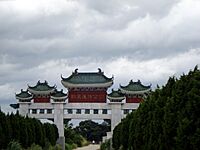
When Ayutthaya fell in 1767, Taksin, then the lord of Tak, broke through the Burmese siege and led his troops to Chanthaburi. During these years, China had conflicts with Burma. Burma's invasion of Siam became a warning for China. Taksin sent a mission to China asking for royal recognition, saying that the old Ayutthaya Kingdom had ended. However, his efforts were blocked by a governor from Hà Tiên, who knew Chinese diplomacy well and claimed Taksin was not the rightful ruler. This governor also gave shelter to an Ayutthaya prince.
The Chinese government eventually saw a chance to ask Taksin to be their ally against the Burmese. Finally, China approved Taksin as the new king of Siam.
A big reason for Taksin's success was the support from the Teochew Chinese trading community. Taksin had Chinese family roots himself. In the short term, Chinese trade provided food and goods needed for his wars to build his new state. In the long term, it brought in money that could be used for the country's expenses and for wealthy families.
One person who lived at the time wrote that during a famine in 1767–1768: "Taksin showed his generous spirit. The poor were no longer without help. The public money was used to help them. Foreigners brought in goods that the country couldn't produce. Taksin proved he deserved to be king by being kind. Problems were fixed, and people and their property were safe. He was very strict with criminals. He made fair laws instead of ruling however he wanted. By making the country peaceful, he made his position strong, and no one who benefited from the peace could claim the throne."
A tomb containing Taksin's clothes and a family shrine was found in Chenghai, China, in 1921. It's believed that a descendant of Taksin sent his clothes there to follow Chinese customs. This supports the idea that this was his father's hometown. Chinese people call it "Tomb of King Zhèng." Princess Sirindhorn of Thailand visited the tomb in 1998. The area around it is now a public park called Zheng Emperor Taksin Park.
Final Years and Death
Thai historians say that the stress of ruling took a toll on King Taksin. He reportedly became very religious. In 1781, he showed more signs of mental distress. He believed he would become a Buddha and expected his blood to turn white. He meditated and even gave lectures to monks. More seriously, he demanded that monks recognize him as a "stream-winner," a high level of spiritual enlightenment. Monks who refused to worship him were punished.
The country also faced economic problems due to constant wars. Famine spread, and crime was common. Many officials were reportedly corrupt. King Taksin punished them harshly. This made many officials unhappy.
Some historians suggest that stories of his "insanity" might have been made up to justify his removal from power. However, letters from a French missionary in Thonburi at the time support accounts of his unusual behavior. The missionary wrote that Taksin "spent all his time in prayer, fasting, and meditation, in order by these means to be able to fly through the air." The missionaries also described how the king "imprisoned, tortured, and flogged, according to his whim, his wife, his sons, and his high officials."
So, the term "insanity" might have been how people at the time described his actions. With the Burmese threat still present, a strong ruler was needed.
Finally, a group led by Phraya San took control of the capital. King Taksin surrendered without fighting and asked to become a monk at Wat Arun. However, there was widespread unrest in Thonburi, with killings and looting. General Chao Phraya Chakri was fighting in Cambodia when the coup happened. He quickly returned to the capital. Upon arrival, he stopped the rebellion, arrested those involved, and restored peace.
According to Thai historical records, General Chao Phraya Chakri decided to execute Taksin. He believed the king had acted improperly and caused great suffering. The records state that Taksin was beheaded on April 10, 1782. His body was buried at Wat Bang Yi Ruea Tai. General Chakri then became king, founding the House of Chakri.
Other accounts exist. Vietnamese records say Taksin was executed in the traditional Siamese way: sealed in a velvet sack and beaten to death with a sandalwood club. Another story claims Taksin was secretly sent to a palace in Nakhon Si Thammarat and lived there until 1825, while someone else was executed in his place. King Taksin's ashes and those of his wife are believed to be at Wat Intharam Worawihan in Thonburi.
Debates About the Coup
It's not entirely clear what role General Chakri played in the coup. Some Vietnamese records say King Taksin had mental health issues in his last years and imprisoned Chakri's family. These records suggest that Chakri and his brother became friends with Vietnamese generals and swore to help each other. After the coup, Chakri returned, stopped the rebellion, and had Taksin killed. Some Vietnamese sources say Chakri assassinated Taksin, while others say Taksin was sentenced to death and executed publicly.
Another idea is that General Chakri wanted to be king and accused Taksin of being too Chinese. This view suggests that later historical accounts were written to make the new king, Rama I, seem more legitimate. Historian Nidhi Eoseewong suggests Taksin was a new kind of leader who promoted a "decentralized" kingdom and new nobles of Chinese merchant background. In contrast, Phraya Chakri and his supporters were from the "old" Ayutthaya nobility who disliked these changes.
However, Chao Phraya Chakri himself had some Chinese ancestry and was married to one of Taksin's daughters. Historical records don't mention any previous conflicts between them. Reports of conflicts between the king and Chinese merchants were likely due to controlling rice prices during the famine. Before returning to Thonburi, Chao Phraya Chakri had Taksin's son executed in Cambodia.
Another theory suggests that Thailand owed China a lot of money. To cancel this debt, King Taksin might have pretended to be executed.
King Taksin's Legacy
Some historians see King Taksin as different from the kings of Ayutthaya. He had different origins, policies, and leadership style, representing a new class of leaders. During the Bangkok Period, until 1932, King Taksin was not as highly honored as other Siamese kings. This was because the leaders of the Chakri Dynasty were still worried about their own right to rule.
After 1932, when Thailand became a democracy, King Taksin became more honored than ever. He was seen as a national hero. This was partly because leaders at that time wanted to celebrate historical figures to support their ideas of nationalism and patriotism.
A large statue of King Taksin the Great stands in the middle of Wongwian Yai (the Big Traffic Circle) in Thonburi. The king is shown on horseback, holding a sword. The statue is about 9 meters tall. The monument was opened on April 17, 1954. Every year on December 28, the date of his coronation, a royal ceremony is held to honor King Taksin.
Another monument shows King Taksin on horseback with his four trusted soldiers. It is in Tungnachaey public park in Chanthaburi.
In 1981, the Thai government officially gave King Taksin the honorary title "the Great." To honor Thai monarchs with this title, the Bank of Thailand issued a special series of banknotes. King Taksin's monument in Chanthaburi appears on the back of the 20-baht note issued on December 28, 1981. This date is the official day to honor King Taksin, though it's not a public holiday.
The Na Nagara family is directly descended from King Taksin.
The King Taksin the Great Shrine is on Tha Luang Road in Chanthaburi. It's an important place that shows the strong connection between the people of Chanthaburi and King Taksin. It's a nine-sided building with a pointed helmet-shaped roof. Inside, there is a statue of King Taksin.
The Royal Thai Navy has also named a ship, HTMS Taksin, after him to honor his memory.
Two hospitals are named after him: Taksin Hospital in Bangkok and Somdejphrajaotaksin Maharaj Hospital in Tak Province.
King Taksin's Children
King Taksin had 21 sons and 9 daughters:
|
|
Battles Fought by King Taksin
- Siege of Ayutthaya (1766–1767): Defeat
- Battle of Pho Sam Ton (1767): Victory
- Battle of Bang Kung (1767): Victory
- Invasion of the State of Phitsanulok (1768): Defeat
- Invasion of the State of Phimai (1768): Victory
- Invasion of the State of Nakhon Si Thammarat (1769): Victory
- Invasion of the State of Sawangburi (1770): Victory
- Siege of Chiang Mai (1770): Defeat
- Invasion of Hà Tiên (Banteay Mas) (1771): Victory
- Battle of Phichai (1771): Victory
- Siege of Chiang Mai (1771): Defeat
- Battle of Phichai (1773): Victory
- Siege of Chiang Mai (1774): Victory
- Battle of Bangkaeo (1774): Victory
- Siege of Phitsanulok (1775–1776): Defeat
Images for kids



